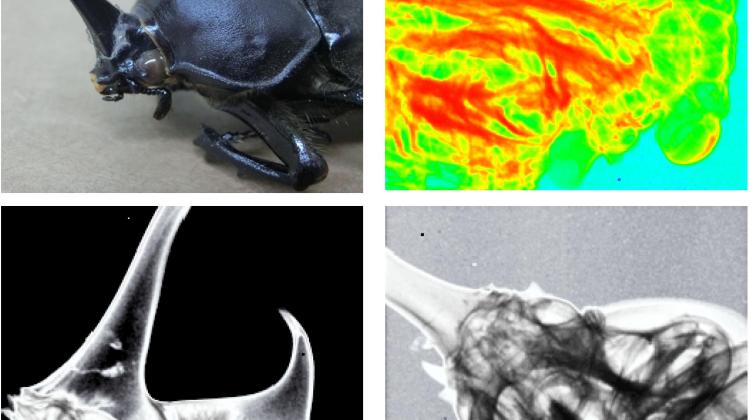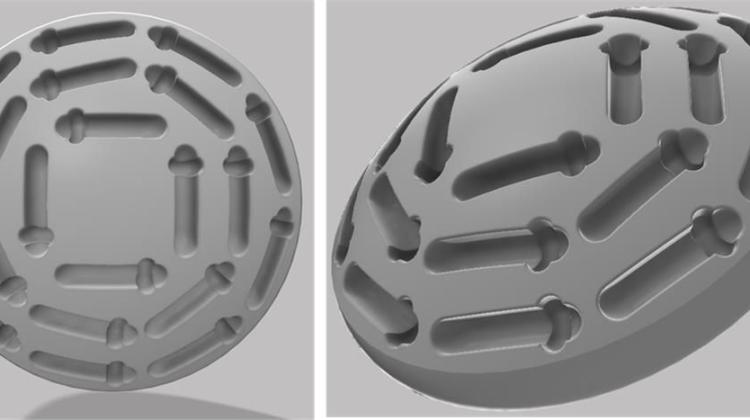Poles develop a super-fast X-ray camera
 Rhinoceros beetle - photo and sample radiographs Fig. P. Gryboś, P. Maj
Rhinoceros beetle - photo and sample radiographs Fig. P. Gryboś, P. Maj
Super fast and precise digital camera that captures X-rays has been developed by researchers from AGH. The solution can be useful when scanning luggage, in medical diagnostics, studying works of art, as well as in the study of the structures of different materials.
X-ray detector capable of counting single photons and registering 20 thousand frames per second has been developed by researchers from the AGH University of Science and Technology in Kraków. In mid-April their solution won gold medal with distinction at the exhibition of inventions in Geneva.
Thanks to X-ray radiation - photons with sufficiently high energy - it is possible to non-invasively see what is inside of an object or examine the structure of materials. This is useful not only for customs officers to scan luggage at airports or for doctors to perform X-rays of fractured bones or CT scans to obtain a cross-section of any part of the body of the patient. Radiation also allows to check the chemical composition of certain materials, examine works of art or check the structure of materials, for example to detect flaws in metal structures and machine components. Now, thanks to the Polish solution, such measurements can be performed with even greater precision.
The X-ray camera requires two main components to function: the X-ray generator and detector. Polish engineers focused on the latter part.
Polish camera is very fast - it captures up to 20 thousand frames per second. "This allows to watch the changing states of test materials or capture fast-moving objects" - said in an interview with PAP one of the creators of solutions, Prof. Paweł Gryboś from the Department of Metrology and Electronics of AGH University of Science and Technology in Kraków.
This type of solutions are needed in the electronic, automotive, pharmaceutical industry and various other branches of the economy, where the quality of production is controlled with the use of X-rays. Scientists in the United States already use Polish cameras to study new materials using synchrotron - a powerful source of X-rays.
Polish device also has an unprecedented precision and method of operation. Until now, X-ray cameras only showed the sum of the charges generated by the photons in a single pixel. So, for example, they could not distinguish between one photon with high energy and a number of photons with lower energies. Meanwhile, the camera from AGH detects single photons: it counts them and determines their energy. "5 million photons per second can enter a single pixel, and our camera will process them correctly. This opens new possibilities, for example for computed tomography" - said Prof. Gryboś. According to him, it is important because photons with different energies can carry a variety of information about the object, through which they passed. This will improve image quality and allow to reduce the dose of X-ray during examination.
The core of the camera are integrated circuits designed at AGH University of Science and Technology in Kraków. "Each chip contains more than 50 million transistors. At AGH we design this type of integrated circuits, transistor after transistor, thanks to a very advanced technologies" - emphasised the researcher. He noted that within a single pixel, which has a size of 75 microns x 75 microns (surface area smaller than the cross-section of a hair), researchers have to fit up to 2 thousand transistors, and the operation of each of them is described with complex models. "We had to design a system better than anyone in the world. Now - after three years of research - our solution is reliable, accurate and faster than the proposals of other researchers" - said the researcher from AGH.
A single detector module has a size of 2 cm x 2 cm, but modules can be easily connected to obtain produce any size of detector.
The research was funded by the National Centre for Research and Development. Product marketing is scheduled for 2017.
PAP - Science and Scholarship in Poland, Ludwika Tomala
lt/ agt/ mrt/
tr. RL
Przed dodaniem komentarza prosimy o zapoznanie z Regulaminem forum serwisu Nauka w Polsce.

















